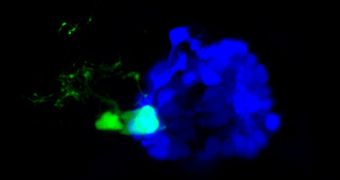Some people really have a problem with telling rapidly which is right and which is left (researches proved that women more than men), but your brain doesn't. Your left brain and right brain are quite different. The right brain hemisphere is linked mostly to emotional functions and music feeling, while the left hemisphere is more analytical, linked to logical thinking, speech and abilities.
A new research carried out by a team led by Stephen Wilson at the University College London, and published in the journal "Neural Development," shows for the first time how the left and right parts of our brain are wired at neuronal level.
The team focused on the left- and right-sided neurons (brain cells) in the brain nucleus called the habenula in zebrafish, in this case similar to that of the human brain. The team made the habenular neurons to synthesize a bright green fluorescent protein which enabled the researchers to visualize their axons, the long nerve fibers that transmit information between neurons.
"It's clear that the left and right halves of the brain process different types of information, but almost nothing is known about the differences in the brain's circuitry which achieve this. One possibility is that totally different types of neuron might be found on the left and right. Alternatively, both sides could contain the same building blocks but put them together in different ways," said Wilson.
The team found two types of habenular neurons, both encountered in the left and the right side. But the left neurons predominantly had spiral axons shaped into a domed crown. These neurons were scarce on the right. Most of the right neurons made flat, shallow spirals, very rare in the left side of the habenula.
"In the same way that an engineer can make different electronic circuits from the same set of electronic components, so the left and right halves of the brain use the same types of neuron but in different combinations," said co-author Isaac Bianco, a UCL student who did this work as part of his Ph.D. research.
The left and right habenular neurons connect to the same brain area, where their signals either combine or are processed independently.
"Even though language is processed largely on the left side of the human brain, people don't speak with only one half of their mouth. The brain must contain circuits which take information from the left or right and then send it on to targets on both sides of the body," said Wilson.

 14 DAY TRIAL //
14 DAY TRIAL //